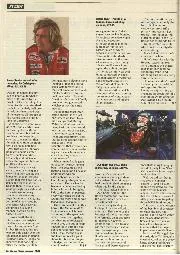
James Hunt- portrait of a champion
by Christopher Hilton. PSL, £9.99 Well, if I'm honest it's difficult to know quite what to make of this book by the prolific Hilton. Certainly, it is not up to…
Is there money as well as eco-glamour in electric racing?
It seems there may well be. Last month Formula E announced that it will exceed revenues of €200m when it lodges its accounts for the 2018-19 period and will report a profit for the first time since its launch back in 2014.
Having reported operating losses of €20.6m and €26.4m in the 2016-17 and 2017-18 respectively, the figures appear to support the bullish mood of its chairman, Alejandro Agag, who claimed the series hit a valuation of £534m last year.
Agag hailed the September results as proof that the series is on the right track. “Reaching break even is a historic moment for us,” he said. “For a business that almost didn’t make it after three races, now after 60 races we reach break even – and with strong revenue growth – and that is going to continue”.
The biggest area of growth was in sponsorship thanks to the backing of four new corporate endorsements, with German electricals group Bosch, Dutch beer maker Heineken, French champagne brand Moët & Chandon and Saudi Arabian Airlines.
The fact that growth has been driven by sponsorship has raised eyebrows among some commentators who regard the business model as too reliant on that revenue stream.
Most motor racing rights holders get the majority of their revenue from three main sources: broadcasters, sponsorship and race organisers.
Agag didn’t provide a full breakdown of the 2019 results – which have yet to be filed – but an indication of the relative weight of each can be seen in previous year’s full results. In those, sponsorship and race organisers are lumped together in the race promotions and licensing category in the Formula E Operations accounts.
FEO’s 2017 accounts showed that sponsorship revenue came to £41.8m which puts the promotion fees paid by its nine race hosts at just £5.3m. In contrast, F1 generated £483m from race promotion fees in 2017 and although it had 11 more events than Formula E, this still comes to £24.2m each. It means F1’s average race hosting fee is a staggering 40 times higher than the amount commanded by its electric counterpart.
That’s because of a decision which was made before the series even launched. In order to get traction for Formula E, Agag took a different approach to F1 and generally didn’t charge a fee for hosting races in the early days. “What we want from the cities is their best premium space. That’s what we ask from the city, we don’t ask for money,” he said in 2013.
So despite its success – and now in its sixth season – asking race organisers to pay for something which was previously free is a hard ask and this may be one of the reasons that so many new events have joined the Formula E calendar since the series launched.
The FEO accounts even acknowledge that “risks are apparent in the changing city line-up. Organising races on city streets brings its own challenges but as city street racing is part of the DNA of the series and holds appeal to a broad market audience, the Group continues to pursue effective city/promoter agreements.”